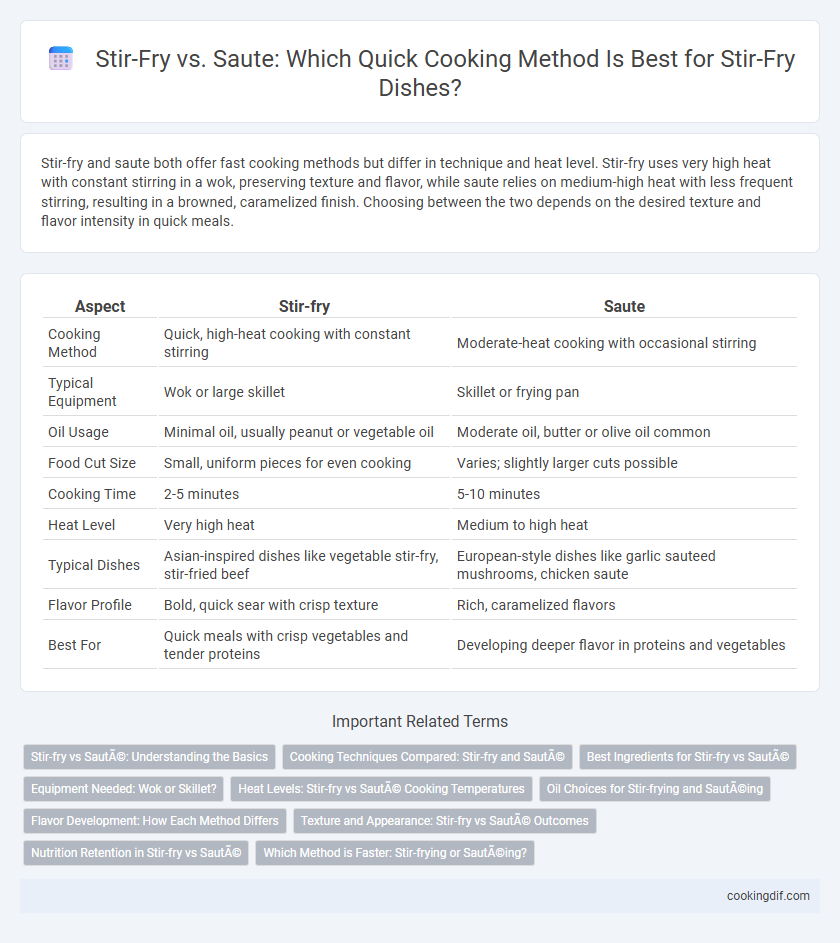Stir-fry and saute both offer fast cooking methods but differ in technique and heat level. Stir-fry uses very high heat with constant stirring in a wok, preserving texture and flavor, while saute relies on medium-high heat with less frequent stirring, resulting in a browned, caramelized finish. Choosing between the two depends on the desired texture and flavor intensity in quick meals.
Table of Comparison
| Aspect | Stir-fry | Saute |
|---|---|---|
| Cooking Method | Quick, high-heat cooking with constant stirring | Moderate-heat cooking with occasional stirring |
| Typical Equipment | Wok or large skillet | Skillet or frying pan |
| Oil Usage | Minimal oil, usually peanut or vegetable oil | Moderate oil, butter or olive oil common |
| Food Cut Size | Small, uniform pieces for even cooking | Varies; slightly larger cuts possible |
| Cooking Time | 2-5 minutes | 5-10 minutes |
| Heat Level | Very high heat | Medium to high heat |
| Typical Dishes | Asian-inspired dishes like vegetable stir-fry, stir-fried beef | European-style dishes like garlic sauteed mushrooms, chicken saute |
| Flavor Profile | Bold, quick sear with crisp texture | Rich, caramelized flavors |
| Best For | Quick meals with crisp vegetables and tender proteins | Developing deeper flavor in proteins and vegetables |
Stir-fry vs Sauté: Understanding the Basics
Stir-fry involves cooking small, evenly cut ingredients rapidly over very high heat while continuously stirring in a wok, preserving texture and flavor. Saute uses moderate heat with less frequent stirring, allowing food to brown and develop a caramelized crust. Both methods offer quick cooking options, but stir-frying is ideal for crisp-tender vegetables and bite-sized protein pieces, whereas sauteing suits thicker cuts and ingredients needing a golden exterior.
Cooking Techniques Compared: Stir-fry and Sauté
Stir-fry and saute both use high heat and a small amount of oil to cook food quickly, preserving texture and flavor, but stir-frying requires constant stirring in a wok to evenly cook thinly sliced ingredients at very high temperatures. Sauteing involves cooking food in a shallow pan with less vigorous stirring, suitable for larger cuts like vegetables or meat, allowing a slight caramelization for enhanced flavor. The wok's curved shape in stir-frying promotes rapid, even heat distribution, while sauteing relies on flat pans for direct heat contact and browning.
Best Ingredients for Stir-fry vs Sauté
Stir-fry excels with thinly sliced vegetables and tender proteins like beef, chicken, or tofu that cook quickly at high heat, preserving crispness and flavor. Sauteing works best with ingredients that benefit from slower, even cooking such as mushrooms, onions, and denser vegetables like carrots or potatoes sliced thinly. Choosing the right oil with a high smoke point, like peanut or canola oil for stir-fry, and butter or olive oil for saute enhances taste and prevents burning.
Equipment Needed: Wok or Skillet?
A wok's deep, sloped sides and high heat capacity enable rapid, even cooking essential for stir-fry, while a skillet's flat surface suits sauteing with moderate heat. Stir-frying requires a wok and a high-BTU burner to maintain the intense heat needed to sear ingredients quickly, preserving texture and flavor. Sauteing typically uses a skillet on a standard stovetop, allowing more controlled, gentle cooking ideal for browning and tenderizing food.
Heat Levels: Stir-fry vs Sauté Cooking Temperatures
Stir-fry cooking typically requires high heat levels ranging from 375degF to 450degF to quickly sear ingredients while preserving texture and flavor, whereas sauteing uses moderate to medium-high heat around 320degF to 375degF for more controlled cooking. The intense heat in stir-frying allows rapid caramelization and Maillard reactions, maximizing aroma and color in a short time. Sauteing's lower temperature range ensures even cooking and browning, ideal for delicate proteins and vegetables that need careful temperature management.
Oil Choices for Stir-frying and Sautéing
Choosing the right oil is crucial for stir-frying and sauteing due to their different cooking techniques and temperatures. Stir-frying requires oils with high smoke points such as peanut, grapeseed, or canola oil to withstand the intense heat without breaking down or producing harmful compounds. In contrast, sauteing, performed at moderately lower temperatures, allows for the use of oils with medium smoke points like olive oil or butter, enhancing flavor while ensuring optimal cooking performance.
Flavor Development: How Each Method Differs
Stir-fry cooking uses high heat and constant movement to quickly sear small, evenly cut ingredients, enhancing flavor through Maillard reactions and caramelization. Sauteing involves moderate heat with less agitation, allowing ingredients to cook more slowly and develop a different depth of flavor by gently breaking down sugars and proteins. Stir-frying intensifies bold, crisp textures and vibrant flavors, while sauteing produces a richer, more mellow taste profile.
Texture and Appearance: Stir-fry vs Sauté Outcomes
Stir-fry cooking preserves a crisp-tender texture and vibrant color in vegetables through high heat and rapid tossing, enhancing visual appeal and mouthfeel. Sauteing typically results in a softer texture and more caramelized, browned appearance due to slower cooking at moderate heat. The distinct outcomes in texture and appearance stem from stir-fry's constant movement versus the more stationary nature of sauteing.
Nutrition Retention in Stir-fry vs Sauté
Stir-fry cooking preserves more nutrients compared to sauteing due to its high heat and rapid cooking time, which minimizes vitamin and mineral loss. The continuous stirring and use of a small amount of oil in stir-fry help retain water-soluble vitamins like vitamin C and B-complex, which are often degraded in longer cooking processes such as sauteing. Research shows that stir-frying vegetables can retain up to 70-80% of their original antioxidant content, whereas sauteing generally results in a higher nutrient decline.
Which Method is Faster: Stir-frying or Sautéing?
Stir-frying is generally faster than sauteing due to its use of higher heat and constant stirring, which cooks small, uniformly cut ingredients quickly. Sauteing typically involves moderate heat and less agitation, resulting in slightly longer cooking times. For rapid preparation of thinly sliced vegetables or proteins, stir-frying is the optimal method.
Stir-fry vs sauté for quick cooking Infographic

 cookingdif.com
cookingdif.com